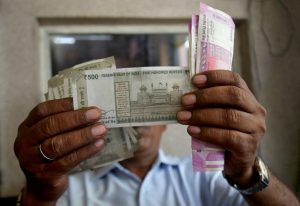The Business Value of SD-WAN for Retailers Pursuing Digital Transformation

KV Prasad Jun 13, 2022, 06:35 AM IST (Published)
 Listen to the Article (6 Minutes)
Listen to the Article (6 Minutes)
Summary
IDC OPINION For retailers, the branch is where customers are served, where business is transacted, where revenue is earned, and where the brand is established and enhanced. Applications and data are increasingly valuable in these environments, and the network is the critical conduit that connects applications and data to users, including customers, employees, and partners. …
Continue reading “The Business Value of SD-WAN for Retailers Pursuing Digital Transformation”
IDC OPINION
For retailers, the branch is where customers are served, where business is transacted, where revenue is earned, and where the brand is established and enhanced. Applications and data are increasingly valuable in these environments, and the network is the critical conduit that connects applications and data to users, including customers, employees, and partners. In the era of digital transformation (DX), amid the adoption of cloud-centric technologies and operating models, the WAN is the network that most
requires modernization to achieve better business outcomes and competitive differentiation in retail. In this white paper, IDC examines the need for software-defined WAN (SD-WAN) in the retail industry — why it is needed, the challenges it resolves, the benefits it provides, and the use cases it addresses.
We also consider how Dell and VMware have responded to the needs of retailers with SD-WAN solutions that align with key benefits and business outcomes.
SITUATION OVERVIEW
Digital transformation has been a persistent imperative for the retail industry, and the COVID-19 pandemic has only magnified the criticality of DX. Retail leaders are boldly doubling down on DX, while other retailers have struggled with moving from early stages of reaction to the crisis to tactically addressing gaps that have been exposed. This unexpected crisis is scrambling everyone’s DX strategies and priorities. As retailers grapple with the present crisis on top of ongoing disruption in the retail industry, five key trends emerge: first, the need to modernize — futureproof — the retail business and operations; second, the need to better manage and capitalize on data-driven insights and process automation; three, the acceleration of a pragmatic DX focusing on more robust omni-channel services; fourth, the rise of contactless business; and fifth, the acceleration of greater product assortment. The advance and adoption of digital technologies by consumers and companies alike, together with the relentless pursuit of greater market presence and operational efficiency, is driving an acceleration of business and digital innovation that few retailers can ignore. Yet nearly 80% of retailers in a recent IDC survey said that they have done little to no work in applying technology as part of DX or are just
beginning or at an early stage. Recent heightened industry disruption has only further exposed gaps in process, operations, and technological support that retailers need to address in order to be competitive in the retail sector (see IDC’s Industry IT and Communications Survey, July 2020, n = 211). The current crisis only emphasizes the need to engage DX and continual innovation while focusing on operational efficiency and getting customers back into the store.
©2021 IDC #US47208420 2 The pressing needs for operating efficiency and costs control, driven by the hypercompetitiveness in the retail industry and the increasing pressures of omni-channel commerce, have now grown even
more pressing. Cosmic shifts in the retail industry, which were already present, are now being compounded by the pandemic. Retailers that are making their way through the pandemic are learning anew the need for IT agility and operational efficiency and resiliency. More reliance on the cloud will surely be one outcome. A renewed focus on software-defined infrastructure will also be needed to support a critical need in the retail industry for easier and simpler control of an increasingly complex infrastructure. New imperatives for DX, and rapidly increasing enterprise efficiency and operational agility, will bring accelerated adoption of SD-WAN to the retail industry.
Benefits of SD-WAN for Retailers
The benefits stemming from the use of SD-WAN come both from the potential business impact that can have on the retail business and directly from inherent technological advantages that SD-WAN has over competing technologies. Customer experience is a central focus for retailers. The branch or remote site is where customers are served, where business takes place, where transactions occur, and where the brand is experienced. The advanced technology of SD-WAN also offers significant improvements over legacy network technologies because of its software-based design, cost efficiencies, and other technical improvements. Retailers are responding to unprecedented industry challenges requiring heightened operational and IT agility and greater innovation. To effectively address these challenges, retailers will turn to increased use of automation and greater leverage of cloud-based technologies in increasingly complex hybrid cloud environments running workloads that are increasingly of high bandwidth and latency sensitive. In a recent IDC survey, retailers were asked to name their top technology initiatives currently active in their organization; the top initiatives named were 3D printing, IoT, business analytics, augmented reality, mobile applications, and mobile devices. In the wake of the COVID-19 pandemic, other technologies such as digital workspaces, fresh investments in network equipment, converged safety and security technologies, expanded use of video, mobile ordering, and contactless transactions will rise in prominence, with edge and 5G on the horizon.
With the confluence of these trends, the drivers for SD-WAN become clear:
▪ Need for better operational agility
▪ Pressure to control retail operational costs
▪ Accommodate the rapid expansion of work-from-home workforce
▪ Need to manage IT environments that are growing in complexity
▪ Ability to manage bandwidth constraints from legacy network technologies
▪ Adoption of higher-demand applications and technologies
The drivers for SD-WAN are differentiated by retail size and sector. Large enterprises are deploying SD-WAN across the enterprise to address expanding IT portfolios that require more agile, secure, and reliable network bandwidth that can grow with their adoption of more demanding and higher performing applications and technologies. The higher functionality of SD-WAN also gives the smaller retailer greater agility, better use and allocation of bandwidth, cost efficiencies over MPLS, and better handsoff management — important for retailers with limited IT resources. The ability to quickly scale up and scale down operations is proving to be a key dimension of retail agility. Retailers are finding that SD-WAN can significantly accelerate the ability to set up required network capabilities. At a time when speed of operationalizing a retail operation more quickly means that customer traffic and store revenue and profits can be realized faster, turning to SD-WAN for faster deployment of network capabilities can prove to be a game changer. For new store openings as well as expansion of operations, retailers are also leveraging SD-WAN to
avoid MPLS connections that are more costly when the retailer finds that its network needs have exceeded the available capacity of an existing MPLS network. When the retailer is expanding and looking at the cost of deploying additional network capacity, the cost comparison between SD-WAN and MPLS for the additional capacity can be significant. This is before even factoring in the benefits of the move to a more software-defined WAN capability.
An added complexity for retailers has been the need to provision networks for a base of work-fromhome users, which has exploded within the past year. Retailers have needed to rapidly expand network connectivity to a remote work force that needs seamless and secure access to the retail enterprise resources. As retailers have deployed more technologies for better real-time operational visibility and to deliver a richer experience to both employees and customers, retailers are also finding that legacy networks were not designed for the technologies being deployed today. Increasing use of video for training,
security, safety, and clienteling needs reliable, assured high bandwidth. And the network needs to be smarter about optimizing data traffic and distinguishing, for example, between backup data flows and payment or POS transactional data. SD-WAN’s ability to optimize data traffic flows and deliver an optimized application experience has become increasingly important. The retail industry has a need to simplify the IT infrastructure and engage more automation to better monitor and control complexity where environments are resistant to simplification. In pursuit of these two mandates — where possible
and where this is difficult, simplifying the job of managing environments of increasing complexity — retailers are looking for ways to put more and enhanced functions onto a fewer number of devices with better software-defined management and control. SD-WAN business benefits should also include providing cost-effective delivery of business applications, satisfying the requirements of the modern branch/remote site, accommodating SaaS and cloud-based applications and services, and improving branch-IT efficiency through automated service provisioning. Another critical benefit that is derived from SD-WAN involves meeting the demands of application SLAs, which directly results in greater productivity and business agility. To be sure, a wellarchitected SD-WAN solution can provide improved network and application performance and availability, especially in relation to cloud applications and services, while also providing cost-effective bandwidth. These benefits should not come at the cost of security, which must be maintained and enhanced in the context of SaaS and other cloud applications.
From a technical and operational perspective, SD-WAN solutions offer compelling value for their ability to simplify and automate WAN operations, improve applications traffic management, and dynamically and securely deliver on the cost-efficiency benefits across the hybrid WAN. SD-WAN solutions make it possible to run real-time and business-critical applications over costeffective broadband internet services without performance or security compromises. These solutions should also provide intelligent path selection on a per-application basis, secure zero-touch provisioning (ZTP), and centralized configuration and automated management. Through these capabilities, SD-WAN solutions should deliver significant cost reductions to retailers that deploy them. Operationally, SD-WAN offerings should facilitate a shift away from device-level configuration and management to application-driven to centralized networkwide management, allowing valuable IT resources to be redeployed dynamically and elastically in response to business needs. In addition to capex and opex cost savings, SD-WAN should respond to the increasingly urgent requirements for agility, increased business productivity, and enhanced customer engagement. Through its ability to employ automation to consistently comply with and enforce business intent, SDWAN must securely and reliably connect users to applications regardless of where they reside, delivering an exceptional digital experience while meeting SLAs.
SD-WAN delivers additional advantages:
- Accelerated zero-touch branch network deployments. With automation and business policybased orchestration, these automated capabilities accelerate provisioning processes, speed deployments, and contribute significantly to operational efficiencies and cost savings. They also speed time to revenue markedly, enabling retailers to provision networks for retail sites far
more quickly — in minutes or hours rather than days or weeks.
- Application availability and performance. By leveraging broadband internet and even 4G/LTE or 5G at the branch, SD-WAN can significantly enhance application availability and overall application performance. This can be achieved by bonding multiple underlay links into a single, robust business-intent overlay that delivers high performance and availability. In the case of an underlying link failure, availability is maintained by instantaneous failover to other available links. In addition, SD-WAN can automatically and intelligently correct for errors resulting from dropped or out-of-order packets.
- Simplifying WAN architecture and management. Through application policy-based control and an overlay architecture that abstracts the underlying network transports, SD-WAN can bring much needed architectural simplicity to provisioning, managing, and supporting the WAN. This simplification can also extend to removing or consolidating network functions at the branch
(e.g., routers and security appliances) while enhancing overall performance and operational agility.
- Reducing dependence on expensive MPLS connectivity. Through its capacity to use broadband internet and LTE at the branch, SD-WAN enables the reliable delivery of services over all available links, thereby reducing dependence on MPLS — lowering costs while keeping pace with changing business needs.
- Increasing IaaS and SaaS performance. The inherent ability of SD-WAN to support the hybrid WAN use cases means users can connect directly to cloud applications using the internet. The SD-WAN securely and automatically steers traffic on a per-application basis, eliminating the requirement to backhaul all traffic to the enterprise datacenter. This optimizes IaaS and SaaS
performance at the branch by minimizing latency, and it also reduces the amount of bandwidth required to carry traffic to the datacenter.
- Faster troubleshooting and remediation. SD-WAN’s actionable analytics and real-time visibility can be used to quickly identify and isolate problems that affect the performance and availability of sites, leading to much faster troubleshooting and remediation of problems. The result is that retailers remain up and running longer, generate revenue, and serve customers.
In addition, SD-WAN can give customers the option of removing legacy routers from the branch, reducing cost and complexity. Organizations with multiple geographically dispersed locations can leverage SD-WAN to not only achieve the aforementioned use cases but also reduce their capex on
branch-based network infrastructure.
CHALLENGES/OPPORTUNITIES
The multiple challenges that retailers face have compounded in the past year, and these challenges promise to change the face of the retail industry for years to come. As the industry looks to emerge from the current crisis to the “next normal,” large retailers are able to double down on DX, reenergize
innovation within their enterprises, and reinvest in new technology priorities. Smaller retailers that are still climbing up the DX maturity curve are identifying the business and process gaps exposed by the current crisis and struggling to make tactical investments to address them. What all retailers have in common is a relentless pursuit of greater operational efficiencies and the need to innovate around the customer experience. DX strategies remain critical to retail business success, perhaps more than ever now, as retail businesses increasingly understand the importance of investing in and implementing modernized IT infrastructure that provides a flexible and responsive
foundation for proactive business resilience. In this context, SD-WAN technology plays a salient and indispensable role, ensuring that the network —
which has effectively become the digital nervous system that supports critical applications and services — remains fit for purpose even amid trying circumstances and unforeseen events. Despite many demands and the exceptional circumstances in which retailers have been compelled to operate
and thrive, SD-WAN should be viewed as a key IT infrastructure investment that retailers should assess as part of their next-generation infrastructure strategies.
CONCLUSION
For the retail industry reeling from industry disruption compounded by the pandemic crisis, SD-WAN delivers future-ready software-defined benefits of simplified management and control and reliable network bandwidth. As the retail industry traverses and emerges from the current crisis, the increasing
IT sophistication of the retail IT environment will continue. The need for both operational efficiency and next-generation retail IT infrastructure will increase. In addition, the need for more automated, handsoff management and control over the IT environment will also increase. Retailers can expect to increasingly run up against network constraints as they adopt the evermore high-performance applications and technologies needed to deliver competitive customer experiences. Cost pressures in the retail industry will persist.
The capabilities that SD-WAN delivers are compelling for retailers of all sizes. While specific drivers behind SD-WAN will be stronger among some retailers than for retailers of different sizes or in different sectors, the benefits gained from SD-WAN are shared across all retailers. Retailers are looking for simplified WAN architecture and management, as the complexity of IT environments puts more strain on limited IT resources. The need for considerably more business and IT agility can be enhanced by SD-WAN’s capabilities for zero-touch branch network deployments that deliver network
capabilities with greater speed and agility. Deploying SD-WAN, as retailers anticipate network bandwidth constraints from higher-performance applications and workloads, can remediate bottlenecks before they happen. The cost efficiencies of SD-WAN can deliver cash to the bottom line as SD-WAN displaces or eliminates the deployment of expensive network technologies. As retailers increasingly capitalize on the advantages of cloud technologies in the retail environment, SD-WAN facilitates critical branch-to-cloud application traffic. DX is the foundation for next-generation retail; SD-WAN will be a critical foundation for next-generation retail infrastructure. Dell and VMware are assertively addressing the retail challenges and opportunities with a joint solution that is positioned to be a strong challenger in the SD-WAN sector

Elon Musk forms several ‘X Holdings’ companies to fund potential Twitter buyout
3 Mins Read
Thursday’s filing dispelled some doubts, though Musk still has work to do. He and his advisers will spend the coming days vetting potential investors for the equity portion of his offer, according to people familiar with the matter

KV Prasad Journo follow politics, process in Parliament and US Congress. Former Congressional APSA-Fulbright Fellow










 Listen to the Article
Listen to the Article  Daily Newsletter
Daily Newsletter













